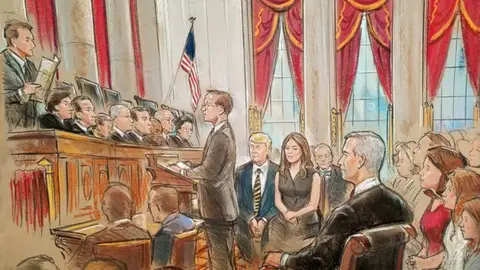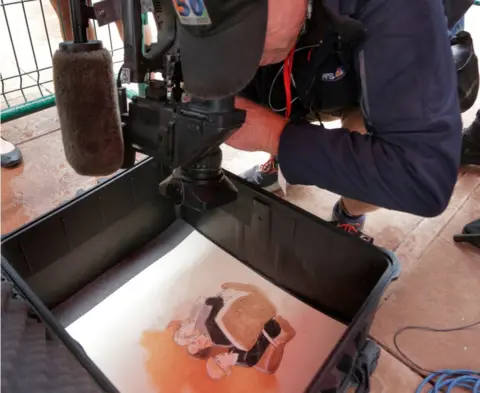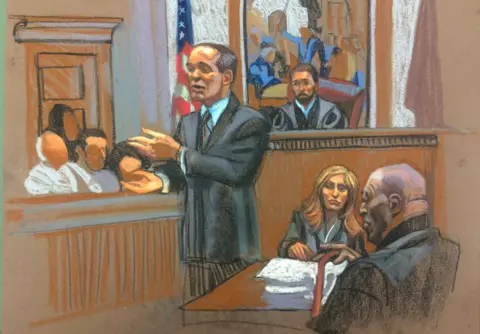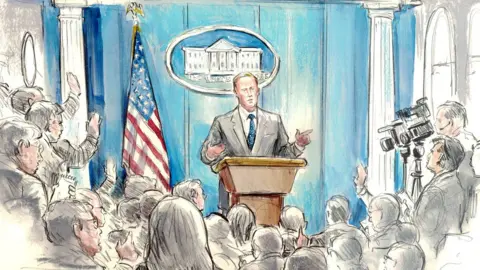Taylor Swift's court sketch: A misunderstood art
 Reuters/Getty
Reuters/GettyPop star Taylor Swift's lawsuit against ex-radio DJ David Mueller, who she alleges groped her, has raised awareness about sexual assault, and the questioning victims face when they take legal action.
Perhaps inevitably, given her high profile and her legions of fans, it's also sparked a debate about the art of court sketches.
Many have criticised the court art, arguing that the drawings look nothing like Taylor Swift - or joking that the artist must be a fan of her rival, Katy Perry.
Allow X content?
And it's not the first time court sketches have been mocked online - sketches of pharmaceuticals CEO Martin Shkreli and NFL player Tom Brady have also seen their fair share of memes and comments.
Allow X content?
Allow X content?
But actually, court sketches play an important role in modern trials - and the artists say there's a lot more to the job than just sketching a likeness.
Why are there court artists anyway?
It's often the only way we can get a visual insight into how a trial looks.
While cameras are allowed in many US courts (and some trials are even televised), cameras are banned from federal courts.
Instead, court artists are used to capture key moments of the trial - including a speaker's expressions, emotions and body language.
Artist William Hennessy Jr, who has covered high-profile trials including those of Chris Brown and Mike Tyson, says it's a challenge because "nobody's there to pose for you".
Celebrity court cases are particularly tough because "the more people know the individual, the more critical they're likely to be - so the pressure is on for you to get the likeness accurate".
 William Hennessy Jr
William Hennessy JrHe likens the job to being a court reporter.
"You want to think journalistically - you're providing a visual for a story," he tells the BBC. "You want to do it in context and provide a feeling of what a courtroom is like."
The deadlines are brutal
Jane Rosenberg was behind the 2015 sketches of Tom Brady that went viral.
After they sparked dozens of memes online, she apologised for "not making him as good-looking as he is" and said she had been "under a lot of pressure to work very quickly".
She did try again - and people were pretty happy with her follow up effort - with one newspaper saying she had nailed it.
Christine Cornell, a court artist who sketched the Bill Cosby trial, agrees the job involves "hideous deadlines".
"You have to get it down very fast - essentially [the moment] the hearing's over is when they want the drawing," she tells the BBC.
 Getty Images
Getty ImagesShe says the least amount of time she's had to do a sketch is about half an hour, although "an hour is more typical".
Sometimes you can barely see their faces
As if the time pressure isn't bad enough - sometimes courtrooms are so crowded the artists can hardly see the person they're meant to be drawing.
"The best hearings are without a jury, when the judge may allow the artist to sit in the jury box - then you're actually looking at the faces of the people you're drawing," Ms Cornell says.
"However, if you're coming in for a hearing you're going to be put in the public area - in which case you're looking at the back of everyone's heads.
 Christine Cornell
Christine CornellIn those cases, she says, court artists need to be good at capturing a person's face from quick glances.
"He may turn to speak to his attorney before the judge comes in, for 30 seconds - you may see his face when he walks in through the door and turns to face the front - those are the moments you wait for so you can capture their likeness."
In the case of the Bill Cosby trial, she was designated a seat behind a pillar - which she describes as "drawing under the very worst of circumstances".
Luckily, she had practised drawing him during the pre-trial hearings where she was allowed in the jury box - "so I could draw him very well with just brief glimpses".
 Christine Cornell
Christine CornellIt's even harder in the UK
If you think US court artists have a tough job, spare a thought for their cousins across the pond.
In the UK, most courtrooms ban cameras - and artists are prohibited from sketching people in court as part of the 1925 criminal justice act.
The artists have to make notes during the hearings - and then draw their impressions from memory.
Julia Quenzler, a court artist in the UK, told the BBC in a previous interview that she would write brief notes about the hair, facial features, clothing and body language of the main players, before scuttling off to the press room to commit the image to paper.
Why aren't cameras allowed in federal courts?
Many judges are against the idea, arguing that that it will change how people behave in court, intimidate witnesses, and make judges and lawyers more likely to perform for the cameras.
Others though argue that cameras would allow more transparency - and give the public a better insight into how the judiciary operates.
Ms Cornell argues that "photos are very unfair in the courtroom, where there's supposed to be a presumption of innocence".
Sketches are less intrusive, and capture "a combination of moments rather than one moment", whereas a photo or still of someone's expression can be taken out of context, she says.
Court sketches are like "drawing with your heart - and a camera doesn't have a heart".
And finally...
For journalists, there's one other benefit of knowing a courtroom artist.
When the White House banned cameras from some of its press briefings, CNN sent Mr Hennessy there instead.
His sketches of White House Press Secretary Sean Spicer attracted a fair amount of media attention, and he said a lot of journalists "kind of got a kick out of seeing me" in a room where cameras weren't allowed.
 William Hennessy Jr
William Hennessy JrSo it's fair to say that even though some court sketches go viral for all the wrong reasons, journalists will keep sending artists to places where cameras are forbidden.
